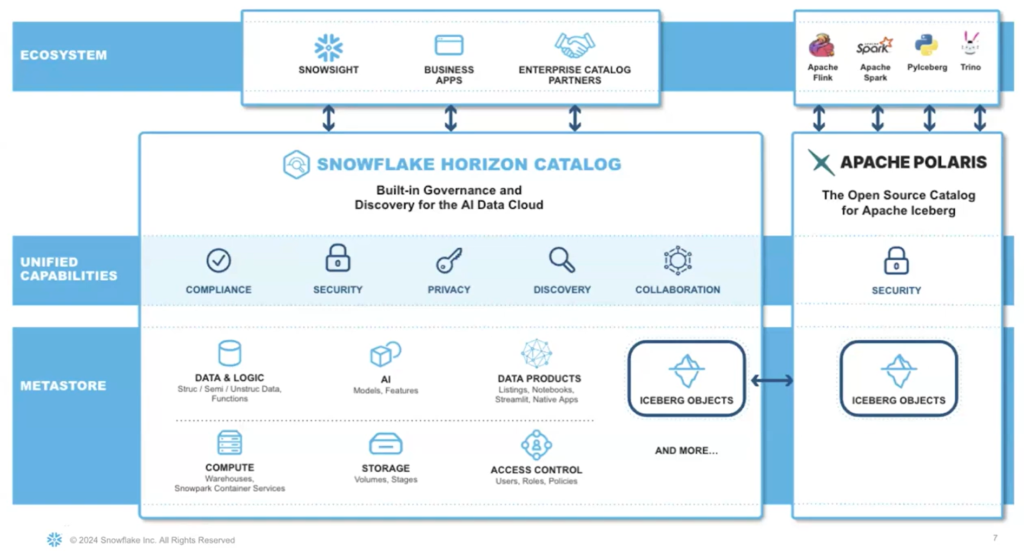In today’s data-centric world, managing and governing large datasets efficiently is crucial for organizations. Apache Polaris and Snowflake Horizon Catalog provide powerful solutions for managing Iceberg tables, combining open-source flexibility with advanced governance features. This blog explores how these two catalogs interact, highlighting their roles, functionality, and the benefits of integrating them within a modern data management strategy.

source @https://www.snowflake.com
Overview of Apache Polaris and Snowflake Horizon Catalog
Apache Polaris Catalog
Apache Polaris is a newly introduced open-source catalog specifically designed to manage Apache Iceberg tables. Polaris offers a flexible, scalable approach to managing Iceberg tables across various cloud storage solutions, integrating seamlessly with tools like Apache Flink, Apache Spark, Trino, and Snowflake.
Key Features of Apache Polaris:
- Schema Evolution: Easily manage changes to table schemas without disrupting existing data pipelines.
- Integration with External Tools: Supports read and write operations from popular processing engines like Spark, Flink, and Trino.
- Built-in Role-Based Access Control (RBAC): Securely manage access and permissions for different users, ensuring data security and compliance.
Snowflake Horizon Catalog
The Snowflake Horizon Catalog is a core component of the Snowflake platform, managing native objects like tables, views, and other data products. Horizon provides comprehensive data governance capabilities that allow organizations to maintain control over their data assets within the Snowflake environment.
Key Features of Snowflake Horizon Catalog:
- Robust Object Management: Manages Snowflake-native data objects, including tables and views, within a secure and governed environment.
- Advanced Governance Tools: Features such as dynamic data masking, row-level security, and access policies enhance data security and compliance.
- Seamless Integration with Polaris: Provides direct integration with Polaris, allowing users to manage Iceberg tables alongside Snowflake-native data.
Integration of Polaris and Horizon Catalogs
Complementary Functions of Polaris and Horizon
Polaris and Horizon serve distinct but complementary purposes. Polaris manages Iceberg tables, focusing on storage and external tool integration, while Horizon offers advanced governance and access control for Snowflake-native data. When combined, they provide a unified approach to data management.
- Distinct but Integrated: While Polaris and Horizon are separate products, they are designed to work together seamlessly, with Polaris managing Iceberg-specific needs and Horizon offering governance and access control.
- Shadow Entities: Shadow entities in Horizon act as references to Iceberg tables managed by Polaris, allowing Snowflake users to interact with these tables as if they were native to Snowflake.
Benefits of Shadow Entities
- Unified Data Governance: Apply Snowflake’s governance features, like data masking and security policies, to Iceberg tables managed by Polaris.
- Enhanced Data Discoverability: Iceberg tables become accessible within the Snowflake ecosystem, enabling a consistent view of all data assets.
- Cross-Platform Data Management: Supports integration with various external processing engines, providing flexibility in data handling and analysis.
Detailed Management of Data in Apache Polaris
The Polaris Catalog provides a structured approach to managing Iceberg tables, allowing users to create multiple catalogs, establish connections with processing engines, and set access controls.
Creating and Managing Polaris Catalogs
- Multiple Catalogs: Polaris allows the creation of several catalogs, each configured with unique settings and storage locations to optimize data organization and management.
- Service Connections: Establish connections with external tools like Spark and Snowflake, defining how these tools interact with the Polaris Catalog.
Role-Based Access Control (RBAC)
- Managing Access and Permissions: Define roles with specific privileges, such as creating or modifying tables, to maintain secure and controlled access to data.
- Integration with Cloud IAM: Use cloud identity and access management (IAM) roles to further secure data access between Polaris and cloud storage solutions.
Querying and Governing Iceberg Tables in Snowflake
With Polaris and Horizon integration, Iceberg tables managed in Polaris can be governed using Snowflake’s Horizon Catalog features, providing a unified and secure data management experience.
Advanced Governance and Security
- Dynamic Data Masking: Apply data masking policies to protect sensitive information, such as masking email addresses based on user roles.
- Enhanced Security Policies: Use row-level and column-level security policies to enforce strict access controls on Iceberg tables within Snowflake.
Practical Demonstration: Integrating Spark and Snowflake
- Configuring Spark with Polaris: Set up Spark sessions to connect with Polaris, enabling users to create and manage Iceberg tables directly from their Spark environment.
- Snowflake Integration: Configure Snowflake to query Iceberg tables via Horizon’s shadow entities, demonstrating the seamless integration of external Iceberg data with Snowflake’s governance framework.
Conclusion: Leveraging Apache Polaris and Snowflake Horizon for Enhanced Data Management
The integration of Apache Polaris with Snowflake Horizon Catalog provides a powerful solution for managing and governing Iceberg tables. By combining the open-source capabilities of Polaris with the enterprise-grade governance of Horizon, organizations can achieve greater control, security, and flexibility in their data management strategies.
Key Benefits:
- Unified Governance: Seamlessly apply Snowflake’s governance tools to Iceberg tables managed by Polaris, ensuring consistent data security and compliance.
- Scalable Integration: Support for multiple processing engines and cloud storage solutions makes this integration highly adaptable to various data workflows.
- Improved Data Discoverability: Bring together all data assets under one governance framework, enhancing data accessibility and usability.
This integrated approach empowers businesses to manage their data assets effectively, streamline their data governance processes, and drive better insights from their data. For more information on how to implement and optimize this integration, explore the official documentation and code examples provided by Snowflake and Apache Polaris.
